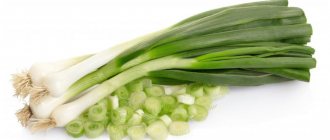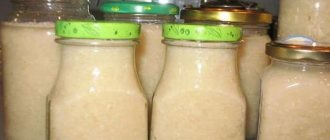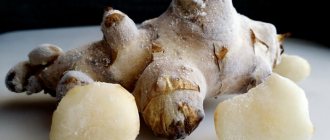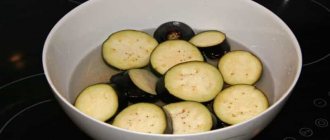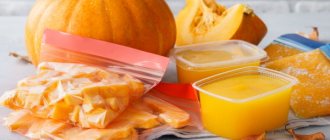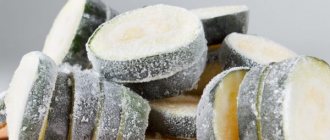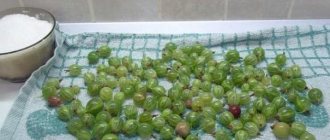AnyutaN — Sep 30th, 2016 Categories: Freezing
Tags: Frozen basil, Freezing herbs
Basil greens are very aromatic, healthy and tasty. This spicy herb is widely used in cooking, as an additive to soups, sauces, meat and fish, as well as in cosmetology. To preserve a little bit of summer, let's try freezing basil in the freezer. Read about all the intricacies and methods of freezing basil for the winter at home in this article.
Ingredients: basil, water, butter, olive oil, sunflower oil, vegetable oil Time for bookmarking: Summer, Autumn
Method 1 - whole leaves
Basil from the market or your own garden can be stored frozen for up to a year, just before the new harvest.
How to freeze whole leaves:
- Freshly picked leaves should be washed thoroughly. Many housewives recommend soaking basil for a short time so that the water draws out as much contaminants as possible. One hour of “bathing” is enough. Miss Clean magazine recommends changing the rinsing water 2-3 times.
- Now the branches need to be dried. Place them on a tray in an even layer, turning them over periodically. You should not dry it at elevated temperatures, otherwise the basil will become fragile and will only be suitable for further drying for seasoning.
- Dried basil sometimes looks a little limp, but that's okay. Just put them in bags and tie them tightly.
- It is better to freeze fragile basil leaves in containers, placing them loosely. This way they won’t break and will look beautiful in the salad.
- If you prefer bags, take two layers so that the bright aroma of greens does not affect the neighboring products in the chamber. This measure will also protect the basil itself from the penetration of foreign odors.
- Be prepared that the greens will darken a little during storage. But if you did everything correctly, then it will remain just as fragrant and healthy.
Advice Basil cuttings should not be woody! Use only soft herbaceous ones, or do without these parts altogether. Cut leaves from the main branch using scissors. By the way, it is also more convenient to chop leaves with scissors.
Storage conditions and periods
You can keep frozen basil fresh for up to 1 year; if the method involved the use of oil, then this period is reduced. Even with careful observance of all storage standards, the spice is suitable for food for no more than one year, since in the future the herb completely loses its beneficial properties.
Attention! It is not recommended to keep frozen basil together with meat or seafood, as there is a possibility of odors being transferred.
Freezing basil for the winter, fresh or processed, is a simple process. There are many options for harvesting this spicy plant, so it’s easy to choose a method that suits you. It is impossible to single out a certain method as “the best”, since certain types of preparations are better suited to certain dishes.
The main condition that will allow you to get maximum benefit and pleasure from basil stored for the winter is compliance with the storage standards for the spice. Only in this case will frozen greens retain their original taste characteristics and beneficial properties. In particular, you should not allow frozen grass to thaw and then re-freeze it. This will completely destroy all the beneficial substances in the plant and reduce its taste.
Video: How to freeze GREENS FOR THE WINTER? 3 WAYS to freeze greens. Quick, easy and simple!
How to freeze GREENS FOR THE WINTER? 3 WAYS to freeze greens. Quick, easy and simple!
Watch this video on YouTube
Video: HOW I FREEZE BASIL FOR THE WINTER
HOW I FREEZE BASIL FOR THE WINTER
Watch this video on YouTube
Do you want to understand better than others?
- How to freeze peaches for the winter: 8 best ways - Freezing will help you preserve a delicious piece of summer. Find out how to choose the right fruits for vitamin preparations, whether they can be stored in the refrigerator, what ways there are to...
- How to freeze and store cilantro in the refrigerator for the winter - Storing cilantro as a preparation for the winter is a good alternative to consuming this spice fresh. Even when cilantro is in the freezer or canned, it actually...
- The most popular ways to freeze chanterelles for the winter - Chanterelles have more pronounced taste characteristics when compared with champignons and oyster mushrooms. However, their significant drawback is the limited period...
- Fruits and vegetables to freeze for the winter in the freezer - You can freeze various products in the freezer. This storage method extends their shelf life, allowing you to save money on the purchase of fresh food products...
- White cabbage: terms and conditions for proper storage - Borscht, cabbage rolls, casseroles and even cutlets and pies are prepared from white cabbage. Preparations from this vegetable are frozen until needed. Below you will find out…
Method 2 - chopped basil
If you don’t want to spend a lot of time cooking, then take care of the green seasoning in advance: just chop the basil leaves before storing it in the freezer.
- Prepare the greens as in the first method. Make sure the basil is completely dry.
- Cut the leaves in any convenient way, but do not overly chop them.
- Distribute into small bags, tie them as tightly as possible so that less air remains.
We recommend: How to properly store semolina so that it does not spoil and become prey for bugs?
Tip A day after placing the basil in the freezer, take out the bag, shake it slightly and return it to its place. Then the greens will not become crumpled.
Freezing basil for the winter at home
You can freeze basil for the winter either in the form of whole leaves or in a crushed state. The plant also retains its beneficial qualities well in the form of puree.
All types of basil are suitable for freezing. The following methods of harvesting this plant for the winter are distinguished:
- fresh;
- freezing with preliminary blanching of leaves;
- pouring seasoning with broth, water or oil;
- in the form of puree.
In general, all these methods are very similar, with the exception of some details. Regardless of the freezing scheme, the main thing is to adhere to the basic rules of harvesting greens for the winter during the process.
How to Freeze Basil Leaves Fresh
Fresh basil can be frozen according to the following scheme:
- The leaves are thoroughly rinsed in cold running water, and then laid out to dry on paper napkins, a baking sheet or a towel. In order to speed up this process, you can gently blot the leaves.
- Place the dried seasoning on parchment paper and place it in the refrigerator or freezer for 30-40 minutes. It is important to arrange the basil so that the leaves do not touch each other - otherwise they may stick together.
- After such preliminary freezing, the seasoning is quickly distributed into individual portioned bags or containers. It is important to do this before the basil defrosts.
- Tightly closed containers are returned to the freezer for winter storage.
Advice! It is better to use special portion bags for freezing, as you can release the air from them, as a result of which the leaves will not darken. It will not be possible to release the air from the container.
How to freeze blanched basil in the freezer
One of the most popular ways to freeze greens involves pre-blanching. Plants are harvested according to the following plan:
- The washed basil is thoroughly chopped by hand or using a blender. It is important here not to chop the leaves too finely - you should not end up with mush.
- The crushed leaves are placed in a colander or sieve, after which they are lowered into boiling water for 10 seconds. It is very important not to overcook the basil - if you keep it in water for too long, it will cook.
- To cool the greens as quickly as possible, immediately after blanching, place a sieve or colander in a container of cold water. For better cooling, you can fill the vessel with ice cubes.
- Spread the cooled basil in an even layer on a plate, tray or baking sheet to dry.
- When the slices are dry, they are placed on the same surfaces in the refrigerator for initial freezing.
- The set greens are quickly placed in containers or bags, and then returned to the freezer.
Advice! If desired, you don't have to chop the basil. Blanching whole leaves is carried out in the same way as in the case of crushed seasoning.
After blanching and cooling, chopped basil can also be placed in ice containers and filled with water (preferably boiled). After ice has formed in the recesses, the cubes are removed from the mold and transferred to containers or plastic bags. Then they are put back in the freezer, in the greens section.
Such cubes can be added to dishes during cooking even without prior defrosting.
Freezing basil for the winter in vegetable oil, broth or water
To freeze this seasoning for the winter, they also use a variety of liquids that are poured over chopped basil. Whole leaves will not work in this case.
The cooking algorithm is as follows:
- The leaves are washed in running water and dried thoroughly.
- Dried herbs are cut using scissors or a knife, but you can also use a blender in the same way. The cutting should be large - if you put the leaves in a blender, you will get a puree.
- When cutting by hand, the leaves are first placed in ice containers and only then filled with oil, broth or water. If you use a blender for chopping, you can add the basil already in the bowl of the device. Recommended proportions of green mass and liquid: 1:2.
- The filled ice trays are placed in the freezer. The oil, broth or water should completely cover the seasoning.
Olive oil is most often used to freeze basil for the winter, but vegetable oil and butter can also be used. Before pouring butter over the greens, you must first melt it.
When frozen by pouring, ice containers can be replaced with sealed bags. To do this, put the greens in a bag, distributing it in a thin layer, and close it tightly. On a flat surface, press deep grooves with a ruler, wire or wooden stick so that squares are formed.
After this, the bag is placed on the bottom of the freezer. When the green mass freezes, you can break off neat plates from it for cooking.
Freezing Basil Puree
In a puree state, the seasoning is prepared as follows:
- The leaves are carefully cut from the stems - twigs are not needed in this case. When growing basil at home, you don’t have to tear out the whole plant, but cut off only the top 10-15 cm. The rest will soon be restored.
- The greens are thoroughly washed in cold running water, after which you can place them in a container with water at room temperature for half an hour. This is done so that the leaves are saturated with moisture.
- After this, the basil is laid out on a towel, damp cloth, baking sheet or tray. You can gently blot the leaves with a towel - this will help them dry faster.
- When the greens are dry, transfer them to the blender bowl, filling the container by one third or half. It is not recommended to pack the container too tightly.
- Before starting the grinding procedure, the seasoning is lightly poured with olive oil with the addition of a small amount of water. This is done so that the basil does not subsequently become covered with dark spots. Additionally, olive oil will give the greens a richer flavor. Recommended oil dosage: 3-4 tbsp. l. one-third to one-half of a blender. If necessary, you can replace the oil with boiled water. The proportions remain the same.
- The leaves are crushed to form a thick, homogeneous paste.
- The resulting mixture is carefully poured into ice containers, after which the containers are put into the freezer.
- If desired, after a day, you can remove the ice-set basil cubes from the molds and place them in a plastic bag for freezing herbs and vegetables or a container. After this, the puree is put back into the refrigerator.
The convenience of freezing greens in a puree state is that the green mass is frozen in portions. This makes the cooking process much more convenient.
Instead of ice cube trays, you can distribute the basil puree into small jars or containers. At the same time, they need to be lightly pressed and poured with a few tablespoons of vegetable oil, without stirring - the layer of oil should evenly cover the surface of the puree. This is done in order to limit air access to the greenery.
Then the jars or containers are hermetically sealed and put in the refrigerator.
Important! The shelf life of puree is much shorter than with other freezing methods - only 3-4 months.
You can learn more about the procedure for freezing basil for the winter from the video below:
Method 3 - with olive oil
Some housewives complain that basil frozen whole becomes ugly and loses its shape. There is a simple way out - make a puree from it with the addition of butter. Among the vegetable groups, the most popular are olive, sunflower and corn. Try not to use oils that are sensitive to low temperatures.
Basil puree with oil is ideal for dressing salads, as a flavorful dressing for soup, for frying, for mashed potatoes, meat and fish dishes, and even for marinade.
How to cook, recipe:
- Rinse the leaves, dry them on a waffle towel or using a hand centrifuge.
- Grind with a blender to a paste.
- Add about 1 tbsp per glass of greens. l. vegetable oil.
- Puree the mixture again for a few seconds, or simply stir with a spoon.
- Distribute into portioned ice or baking trays.
- Send for storage wrapped in two bags.
Tip: Use silicone molds - they are the most convenient for squeezing out portions of greens. From metal and plastic, you will have to pick up the freeze with a knife.
A little trick: in order not to remove the form with the preparation every time, a day after placing it in the chamber, take out the basil, free the portions and pack them in separate bags.
Keeping Basil Fresh
Maintaining the freshness of fragrant greens is quite difficult due to the specific structure of their leaves, which quickly begin to darken and lose their own aroma. Due to this circumstance, it is recommended to buy only freshly picked basil, which does not show signs of darkening or wilting.
Advice! Basil is sold in bunches, so you need to carefully inspect each of them and remove already darkened leaves, as they can cause a faster deterioration in the quality of the spice.
Storing fresh grass is permissible only in places protected from direct sunlight and with a sufficient volume of water. It is possible to increase the freshness of fragrant leaves in the following way:
- The stems are lowered cut side down into a container, similar to a bouquet.
- Afterwards, you need to pour a sufficient amount of water into the container - depending on the volume of the bunch and the capacity of the container, the stems should be covered with liquid by 3-4 cm.
- Storing basil in the refrigerator in this case is not a necessary condition, the main thing is that it should not be exposed to light.
- This way the basil will retain its freshness for 10-15 days.
The upper part of the bouquet, placed in a container with water, can be covered with a plastic bag, and then its edges can be secured with an elastic band on the container. In the case of such packaging, the freshness of the herb can be maintained for 3 weeks.
When the volume of spice is not too large and you plan to consume it within 3-4 days, the stems along with the leaves are wrapped in a damp towel and then sent to the refrigerator. There is an option to preserve the freshness of basil in crushed form - the chopped leaves are placed in a glass container and then a little salt is added to them, poured with a small amount of vegetable (sunflower or olive) oil and closed with a tight-fitting lid. This jar must be placed in the refrigerator. The spice retains its freshness and original qualities with this method of preparation for 2-3 months.
Method 4 - with butter
Butter is also used as a dressing. Take a product with animal fats, as spreads and mixtures with vegetable oils do not melt well and affect the taste of the products. By the way, you can add salt to the basil dressing.
Recipe:
- Melt the butter over low heat until it boils.
- Wash, dry and chop the basil leaves in any convenient way.
- Mix with butter and pour into ice cube trays or use small plastic containers.
We recommend: Terms and rules for storing propolis at home
You can prepare supplements from both purple and green types of basil. Both are very aromatic and full of vitamins.
Finally
These were the four easiest ways to prepare delicious basil, but the housewives’ ideas don’t stop there. Some people freeze crushed leaves in water to make ice cubes. Another recipe uses meat broth instead of water. A popular method is pre-blanching. To do this, the basil is peeled and lightly doused with boiling water.
Thawing basil is as easy as freezing recipes. If you are cooking on the stove, then simply add a cube of greens to the dish. To dress a salad with whole leaves, long defrosting is also not required.
Remember that the longer basil is stored, the less vitamins it contains. Try to use the preparations before spring, and soon a new harvest of early greens will appear.
Selection and preparation of greens
In the evening, water the plant so that it absorbs moisture well overnight and becomes softer and juicier. In the morning, young branches that have not yet begun to bloom are cut off with scissors.
Regardless of the freezing method, a number of preparatory procedures are carried out:
- Carefully inspect the leaves; discard any damaged, dry or diseased specimens. Dried foliage is still suitable for consumption, but is not at all suitable for long-term storage.
- Soak the leaves in water at room temperature for half an hour. A pinch of salt added to the water will get rid of insects remaining on the greens.
- Gently rinse the basil under running water.
- Place the leaves on a paper or waffle towel and wait until it completely absorbs the moisture.
Before freezing, prepare suitable storage containers. It is most convenient to use airtight containers or portioned bags with a zip fastener.
